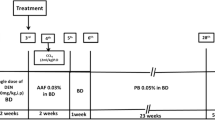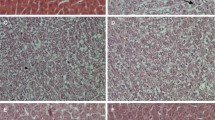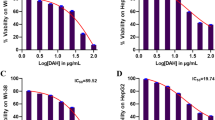Abstract
Hepatocellular carcinoma (HCC) is the fifth leading cause of death and is generally typified by elevated liver enzyme biomarkers, antioxidants, and chronic inflammation of hepatocytes. Although currently available drugs have shown remarkable alleviation of the cancerous condition, but at the same time they present a more severe challenge of toxic effects due to chemotherapy. Therefore, in order to bring more patient-compliant therapy, we aimed to refurbish the use of a COX inhibitor, oxyphenbutazone (OPB), with low dose of methotrexate (MTX) to treat diethyl nitrosamine (DENA)-induced HCC in Wistar rats and in Hep3B cells. Hep3B cells were subjected to assays like in vitro cytotoxicity, DNA synthesis, and caspase activity. The combination index was also evaluated, succeeding the cytotoxicity assay, to analyze the possible synergism. For in vivo study, Wistar strain male rats were given single intraperitoneal dose of DENA (200 mg/kg) and were supplied with sodium phenobarbital (0.1% in tap water) for promoting tumorigenesis throughout the study. MTX (2.5 and 5.0 mg/kg/week, ip) and OPB (70 mg/kg/week, po in two divided doses) were administered to the treatment groups from 3rd week till the termination of study. Several biochemical parameters including biomarkers of liver function, antioxidant enzymes, and histopathological examination of liver cells were tested. Significant synergism was witnessed in the cytotoxicity assay when Hep3B cells received varied dose combination treatment of MTX (0.25, 0.5, or 1.0 µmol/L) and OPB (2.5, 5.0, or 7.5 µmol/L). MTX (0.5 and 1.0 µmol/L) in combination with OPB (5.0 or 7.5 µmol/L) inhibited the cell proliferation as BrdU incorporation was quite low in DNA synthesis analysis, as well as caspase-9/-3 cascade was activated which led to apoptosis of cancer cells. Co-treatment with MTX and OPB exerted potential anticancer activity in rats than either of the drugs alone. Administration of combination therapy harmonized the DENA-induced elevation of serum biochemical parameters, including but not limited to, α-fetoprotein (AFP), alanine- and aspartate-aminotransferase, alkaline phosphatase, vascular endothelial growth factor (VEGF), and antioxidant enzymes like superoxide dismutase (SOD), catalase (CAT), and lipid per oxidation (LPO). All these results were optimally substantiated by histopathological examination. As evident COX-2 catalyzes the synthesis of PGE2, needed in the activation of Wnt/β-catenin pathway, which in turn is responsible for activating the transcriptional proteins required for higher degree of cell division and thence growth. Therefore, inhibition of COX-2 by our novel combination infers that even low doses of MTX can elucidate noticeable anticancer activity when paired with OPB.








Similar content being viewed by others
Abbreviations
- BrdU:
-
Bromodeoxyuridine
- DMEM:
-
Dulbecco’s modified Eagle’s medium
- FBS:
-
Fetal bovine serum
- HCC:
-
Hepatocellular carcinoma
- HEPES:
-
Hydroxyethyl piperazineethanesulfonic acid
- HRP:
-
Horseradish peroxidase
- MTX:
-
Methotrexate
- OPB:
-
Oxyphenbutazone
- SRB:
-
Sulforhodamine B
References
Kundu N, Campbell P, Hampton B, Lin CY, Ma X, Ambulos N, Zhao XF, Goloubeva O, Holt D, Fulton AM (2012). Antimetastatic activity isolated from Colocasia esculenta (taro). Anticancer Drugs 23(2):200–211
Hu S, Sun W, Wei W, Wang D, Jin J, Wu J, Chen J, Wu H, Wang Q (2013) Involvement of the prostaglandin E receptor EP2 in paeoniflorin-induced human hepatoma cell apoptosis. Anticancer Drugs 24(2):140–149
Biziota E, Briasoulis E, Mavroeidis L, Marselos M, Harris AL, Pappas P (2016) Cellular and molecular effects of metronomic vinorelbine and 4-O-deacetylvinorelbine on human umbilical vein endothelial cells. Anticancer Drugs 27(3):216–224
Kim JY, Alam F, Chung SW, Park J, Jeon OC, Kim SY, Son WC, Byun Y (2014) Combinational chemoprevention effect of celecoxib and an oral antiangiogenic LHD4 on colorectal carcinogenesis in mice. Anticancer Drugs 25(9):1061–1071
Ismail B, Fagnere C, Limami Y, Ghezali L, Pouget C, Fidanzi C, Ouk C, Gueye R, Beneytout JL, Duroux JL, Diab-Assaf M, Leger DY, Liagre B (2015) 2′-Hydroxy-4-methylsulfonylchalcone enhances TRAIL-induced apoptosis in prostate cancer cells. Anticancer Drugs 26(1):74–84
Kujubu DA, Fletcher BS, Varnum BC, Lim RW, Herschman HR (1991) TIS10, a phorbol ester tumor promoter-inducible mRNA from Swiss 3T3 cells, encodes a novel prostaglandin synthase/cyclooxygenase homologue. J Biol Chem 266:12866–12872
Vane J (1994) Towards a better aspirin. Nature 367:215–216
Hsu AL, Ching TT, Wang DS, Song X, Rangnekar VM, Chen CS (2000) The cyclooxygenase-2 inhibitor celecoxib induces apoptosis by blocking Akt activation in human prostate cancer cells independently of Bcl-2. J Biol Chem 275:11397–11403
Cheng X, Zhou T, Li B, Li M, Li L, Li Z et al (2013) Methotrexate and 5-aminoimidazole-4-carboxamide riboside exert synergistic anticancer action against human breast cancer and hepatocellular carcinoma. Acta Pharmacol Sin 34:951–959
Koga H, Sakisaka S, Ohishi M, Kawaguchi T, Taniguchi E, Sasatomi K et al (1999) Expression of cyclooxygenase-2 in human hepatocellular carcinoma: relevance to tumor dedifferentiation. Hepatology 29:688–696
Bae SH, Jung ES, Park YM, Kim BS, Kim BK, Kim DG et al (2001) Expression of cyclooxygenase-2 (COX-2) in hepatocellular carcinoma and growth inhibition of hepatoma cell lines by a COX-2 inhibitor, NS-398. Clin Cancer Res 7:1410–1418
Matthews NS, Peck KE, Taylor TS, Mealey KL (2001) Pharmacokinetics of phenylbutazone and its metabolite oxyphenbutazone in miniature donkeys. Am J Vet Res 62(5):673–675
Lima A, Seabra V, Bernardes M, Azevedo R, Sousa H, Medeiros R (2014) Role of key TYMS polymorphisms on methotrexate therapeutic outcome in Portuguese rheumatoid arthritis patients. PLoS ONE 9:e108165
Neradil J, Pavlasova G, Veselska R (2012) New mechanisms for an old drug; DHFR- and non-DHFR-mediated effects of methotrexate in cancer cells. Klin Onkol 25(2):2S87–2S92
Fan LL, Sun GP, Wei W, Wang ZG, Ge L, Fu WZ et al (2010) Melatonin and doxorubicin synergistically induce cell apoptosis in human hepatoma cell lines. World J Gastroenterol 16:1473–1481
Vichai V, Kirtikara K. Sulforhodamine B (2016) Colorimetric assay for cytotoxicity screening. Nat Protoc 1:1112–1116
Chou TC, Talalay P (1984) Quantitative analysis of dose-effect relationships: the combined effects of multiple drugs or enzyme inhibitors. Adv Enzyme Regul 22:27–55
Mai K, Andres J, Bobbert T, Maser-Gluth C, Möhlig M, Bähr V, et al (2007) Rosiglitazone decreases 11betahydroxysteroid dehydrogenase type 1 in subcutaneous adipose tissue. Clin Endocrinol (Oxf) 67(3):419–425
Yiang GT, Chen YH, Chou PL, Chang WJ, Wei CW, Yu YL (2013) The NS3 protease and helicase domains of Japanese encephalitis virus trigger cell death via caspase dependent and independent pathways. Mol Med Rep 7:826–830
Yiang GT, Yu YL, Hu SC, Chen MH, Wang JJ, Wei CW (2008) PKC and MEK pathways inhibit caspase-9/-3-mediated cytotoxicity in differentiated cells. FEBS Lett 582:881–885
Tessitore L, Tomasi C, Greco M, Sesca E, Laconi E, Maccioni O et al (1996) A subnecrogenic dose of diethylnitrosamine is able to initiate hepatocarcinogenesis in the rat when coupled with fasting/refeeding. Carcinogenesis 17(2):289–292
Wang W, Xu GL, Jia WD, Wang ZH, Li JS, Ma JL et al (2009) Expression and correlation of hypoxia inducible factor-1α, vascular endothelial growth factor and microvessel density in experimental rat hepatocarcinogenesis. J Int Med Res 37:417–425
Treon SP, Chabner BA (1996) Concepts in use of high-dose methotrexate therapy. Clin Chem 42:1322–1329
Kern MA, Schubert D, Sahi D, Schoneweiss MM, Moll I, Haugg AM et al (2002) Proapoptotic and anti-proliferative potential of selective cyclooxygenase-2 inhibitors in human liver tumor cells. Hepatology 36(4):885–894
Adams GP, Weiner LM (2005) Monoclonal antibody therapy of cancer. Nat Biotechnol 23:1147–1157
Oshima T, Cao X, Grande F, Yamada R, Garofalo A, Louie S et al (2009) Combination effects of SC144 and cytotoxic anticancer agents. Anticancer Drugs 20:312–320
Goessling W, North TE, Loewer S, Lord AM, Lee S, Stoick-Cooper CL et al (2009) Genetic interaction of PGE2 and Wnt signaling regulates developmental specification of stem cells and regeneration. Cell 136(6):1136–1147
Kaldis P, Pagano M (2009) Wnt signaling in mitosis. Dev Cell 17(6):749–750
Shiota G, Okubo M, Noumi T, Noguchi N, Oyama K, Takano Y et al (1999) Cyclooxygenase-2 expression in hepatocellular carcinoma. Hepatogastroenterology 46:407–412
Staszkiewicz J, Gimble J, Cain C, Dietrich M, Burk D, Kirk-Ballard H et al (2009). Flow cytometric and immunohistochemical detection of in vivo BrdU-labeled cells in mouse fat depots. Biochem Biophys Res Commun 378(3):539–544
Muller M, Strand S, Hug H, Heinemann EM, Walczak H, Hofmann WJ et al (1997) Drug-induced apoptosis in hepatoma cells is mediated by the CD95 (APO-1/Fas) receptor/ligand system and involves activation of wild-type p53. J Clin Invest 99(3):403–413
Martinek R (1969) Practical clinical enzymology. Am J Med Technol 31:162
Drotman RB, Lawhorn GT (1978) Serum enzymes are indicators of chemical induced liver damage. Drug Chem Toxicol 1:163–171
Ploa GL, Hewitt WR (1989) Detection and evaluation of chemically induced liver injury. In: Wallace HA (ed) Principle and methods of toxicology. Raven Press, New York, p 399
Clawson GA (1989) Mechanism of carbon tetrachloride hepatotoxicity. Pathol Immunopathol Res 8:104–112
Chan SL, Mo FK, Johnson PJ, Hui EP, Ma BB, Ho WM et al (2009) New utility of an old marker: serial alpha-fetoprotein measurement in predicting radiologic response and survival of patients with hepatocellular carcinoma undergoing systemic chemotherapy. J Clin Oncol 27:446–452
Kuzuya T, Asahina Y, Tsuchiya K, Tanaka K, Suzuki Y, Hoshioka T et al (2011) Early decrease in alpha-fetoprotein, but not des-gamma-carboxy prothrombin, predicts sorafenib efficacy in patients with advanced hepatocellular carcinoma. Oncology 81:251–258
Shao YY, Lin ZZ, Hsu C, Shen YC, Hsu CH, Cheng AL (2010) Early alpha-fetoprotein response predicts treatment efficacy of antiangiogenic systemic therapy in patients with advanced hepatocellular carcinoma. Cancer 116:4590–4596
Keam B, Oh DY, Lee SH, Kim DW, Im SA, Kim TY et al (2008) A Phase II study of 5-fluorouracil and cisplatin systemic chemotherapy for inoperable hepatocellular carcinoma with alpha fetoprotein as a predictive and prognostic marker. Mol Med Rep 1:415–422
Guba M, von Breitenbuch P, Steinbauer M et al (2002) Rapamycin inhibits primary and metastatic tumor growth by antiangiogenesis: involvement of vascular endothelial growth factor. Nat Med 8:128–135
Yang ZF, Poon RTP (2008) Vascular changes in hepatocellular carcinoma. Anat Rec 291:721–734
Tarnawski AS, Michael KJ (2003) Inhibition of angiogenesis by NSAIDs: molecular mechanisms and clinical implications. J Mol Med 81:627–636
Esterbauer H, Chesseman KH (1990) Determination of aldehydic lipid peroxidation products: malonaldehyde and 4-hydroxy-nonenal. Methods Enzymol 186:407–421
Hietanen E, Ahotupa M, Bartsch H (1987) Lipid peroxidation and chemically induced cancer in rats fed lipid rich diet. In: Lapis K, Kcharst S (eds) Carcinogeensis and tumor progression. Akademiaikiado, Budapest, pp 9–16
Klaunig JE, Kamendulis LM (2004) The role of oxidative stress in carcinogenesis. Annu Rev Pharmacol Toxicol 44:239–267
Heinrich P, Georg L, Petro E (2006) Biochemie und pathobiochemie. Springer, Berlin, p 399
Muller FL, Lustgarten MS, Jang Y, Richardson A, Van RH (2007) Trends in oxidative aging theories. Free Radic Biol Med 43:477–503
Robak J, Glyglewsi RJ (1988) Flavonoids are scavengers of superoxide anions. Biochem Pharmacol 37:837–841
Acknowledgements
Authors are thankful to the Department of Pharmacology, Siddhartha Institute of Pharmacy, Dehradun, Uttarakhand, India, for the approval of the Project (SIP/IAEC/PCOL/01/2016) and all the possible help provided in carrying out this research work.
Author information
Authors and Affiliations
Corresponding author
Ethics declarations
Conflict of interest
Authors have no conflict of interest.
Rights and permissions
About this article
Cite this article
Saleem, S., Khan, R., Afzal, M. et al. Oxyphenbutazone promotes cytotoxicity in rats and Hep3B cellsvia suppression of PGE2 and deactivation of Wnt/β-catenin signaling pathway. Mol Cell Biochem 444, 187–196 (2018). https://doi.org/10.1007/s11010-017-3243-2
Received:
Accepted:
Published:
Issue Date:
DOI: https://doi.org/10.1007/s11010-017-3243-2




